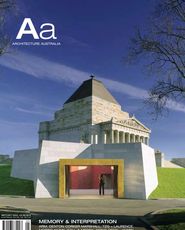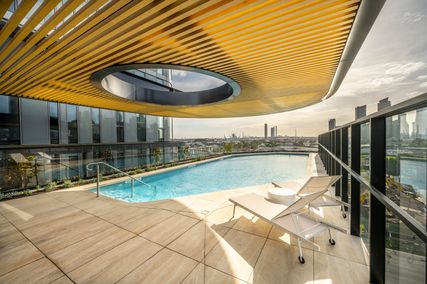MEMORY AND INTERPRETATION
This issue of Architecture Australia gathers together a range of work under the theme memory and interpretation. It presents two broad kinds of projects that have, in recent years, become more common: on the one hand the new spate of memorials, on the other interpretative centres, cultural centres and visitor centres that are now spreading across the country. Where the latter comprise a new, if shifting, type that brings with it new architectural opportunities, the idea of the memorial is a very old one that is now experiencing something of a revival.
In many ways these are very different kinds of projects, yet each involves both memory and interpretation, and they are becoming increasingly entwined: Melbourne’s Shrine of Remembrance now has interpretative exhibitions and displays housed in its undercroft, while the competition brief for the West Gate Bridge Memorial Park required not a monument to move the viewer in an abstract way, but a memorial landscape to also explain and interpret the events commemorated. Memory, often violent or contested, is also at stake in the interpretative structures and centres. These facilities work to re-present and protect both natural history and cultural memory (and these can no longer be understood as distinct and separate bodies of knowledge). Such histories and memories are rarely straightforward – there is always more than one story to tell, more than one memory to invoke, more than one present to consider.
The popularity of such facilities would suggest that immediate experience is no longer enough – or perhaps it is no longer thought possible. Now, in order to visit a place we expect something to explain that place to us, to frame it and re-present it.
So, what might architecture bring to such situations? Architecture has the power to move and engage, to evoke memory and suggest interpretations, but it cannot be didactic or deterministic. By engaging the viewer/occupant, architecture can open up new ways of seeing, thinking and experiencing existing environments and memories, without predetermining them. It calls for something back from the visitor.
Architecture builds on existing environments, but it also helps to shift and change our perception of spaces and places, and the ideas and histories associated with them. Architecture does not simply picture cultures, histories, memory, or natural environments. Through its engagement with the broader public, it helps construct these things for that public. The architect must tread carefully and thoughtfully.
Projects of this kind give architects the opportunity to engage in public buildings, often at quite a small scale. Interpretative centres can give communities – particularly smaller communities – the kind of facility that other public institutions (post offices, libraries etc) used to provide. The architectural reworking of the memorial is making this type pertinent to audiences that have previously disregarded it – for example, the two war memorials published here do not glorify war, but they do honour and dignify those who served and those who died. Together, such projects help ensure that places and memories have an ongoing life.















